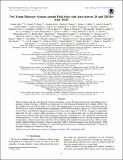Two Young Planetary Systems around Field Stars with Ages between 20 and 320 Myr from TESS
Author(s)
Huang, Chelsea X.; Ricker, George R; Vanderspek, Roland K; Mireles, Ismael; Daylan, Tansu
DownloadPublished version (14.06Mb)
Publisher Policy
Publisher Policy
Article is made available in accordance with the publisher's policy and may be subject to US copyright law. Please refer to the publisher's site for terms of use.
Terms of use
Metadata
Show full item recordAbstract
Planets around young stars trace the early evolution of planetary systems. We
report the discovery and validation of two planetary systems with ages
$\lesssim 300$ Myr from observations by the Transiting Exoplanet Survey
Satellite. TOI-251 is a 40-320 Myr old G star hosting a 2.74 +0.18/-0.18 REarth
mini-Neptune with a 4.94 day period. TOI-942 is a 20-160 Myr old K star hosting
a system of inflated Neptune-sized planets, with TOI-942b orbiting with a
period of 4.32 days, with a radius of 4.81 +0.20/-0.20 REarth, and TOI-942c
orbiting in a period of 10.16 days with a radius of 5.79 +0.19/-0.18 REarth.
Though we cannot place either host star into a known stellar association or
cluster, we can estimate their ages via their photometric and spectroscopic
properties. Both stars exhibit significant photometric variability due to spot
modulation, with measured rotation periods of $\sim 3.5$ days. These stars also
exhibit significant chromospheric activity, with age estimates from the
chromospheric calcium emission lines and X-ray fluxes matching that estimated
from gyrochronology. Both stars also exhibit significant lithium absorption,
similar in equivalent width to well-characterized young cluster members. TESS
has the potential to deliver a population of young planet-bearing field stars,
contributing significantly to tracing the properties of planets as a function
of their age.
Date issued
2020Department
Massachusetts Institute of Technology. Department of Physics; MIT Kavli Institute for Astrophysics and Space Research; Massachusetts Institute of Technology. Department of Earth, Atmospheric, and Planetary Sciences; Massachusetts Institute of Technology. Department of Aeronautics and AstronauticsJournal
Astronomical Journal
Publisher
American Astronomical Society